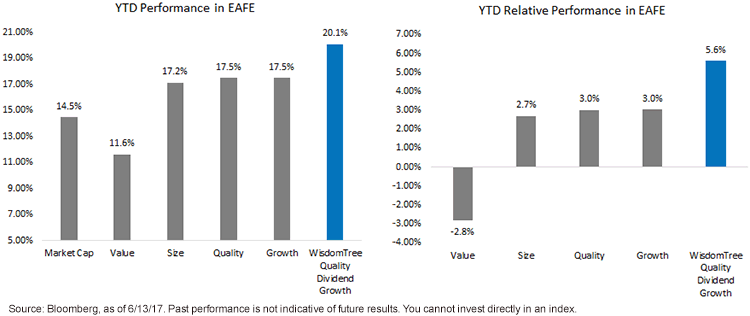Factor Investing 2017: Quality and Dividends Dominate in EAFE


Over the last several months, we’ve seen an increased debate about not only where investors should be allocating, but also how. To answer the first question: While the U.S. has generally been the place to be since 2008, our base case going into 2017 was that there were likely better values to be had in international markets. As for the second question, as one of the earliest proponents of fundamentally weighted Indexes, WisdomTree continues to believe in the ability of dividends to help compound returns over time.
In 2013, our focus expanded to include not only companies with attractive dividend yields but also businesses that may have the ability to meaningfully boost their dividends over time. As a result, we believe that screening dividend-paying companies for quality as well can provide a powerful combination in the current market environment. In our view, the Index that best embodies this for the international markets is the WisdomTree International Quality Dividend Growth Index.
EAFE Factor1 Performance
Year-to-date, the returns of EAFE have significantly outpaced the returns of the S&P 500 Index (14.5% vs. 10%).2 However, we have also seen a rather wide dispersion across most commonly followed investment factors against the market. As illustrated in the chart below, nearly every fundamental factor managed to outperform MSCI’s market cap-weighted approach. The lone exception was that value lagged. In the remainder of this piece, we seek to highlight the primary drivers of performance relative to a market cap-weighted approach.

Value (YTD return: +11.6%)
EAFE value is currently 10% under-weight Consumer Staples relative to the market. Year-to-date, Consumer Staples have been the second strongest performer just behind Technology. Additionally, with financials lagging in a falling-rate environment, value has naturally lagged the broader market.
Size (YTD return: +17.2%)
Most analysts agree that small-cap performance is generally more sensitive to developments in the local economy vs. the global economy. In this case, being over-weight in Japan at the expense of Europe also helped. Additionally, over-weights in Industrials and Technology and an under-weight in Financials helped push small caps higher than the broader market.
Quality (YTD return: +17.5%)
A modest over-weight in Healthcare, particularly in Europe, had the most significant impact on relative index total returns. Similarly, a more pronounced over-weight in Consumer Staples has also led to outperformance for quality relative to market cap.
Growth (YTD return: +17.5%)
Similar to quality, growth strategies generally outperformed, given their 10% over-weight in Consumer Staples. While Energy only represents a small percentage of EAFE, growth strategies have virtually no exposure to Energy, the worst-performing sector YTD.
WisdomTree International Quality Dividend Growth (YTD return: +20.1%)
Significant over-weights in the Consumer (Staples, Discretionary) and Healthcare sectors, combined with significant under-weights in Financials, were the primary drivers of the performance differential. Interestingly, WisdomTree’s methodology added value in nearly every sector excepting Utilities (2.3% weight). To put this performance in perspective, allocations to quality dividend growth in EAFE have delivered returns double those of the S&P 500 so far in 2017.
Time to Buy? Rebalancing into Strength
In closing, after a strong period of outperformance, many investors question whether they’ve missed the rally and should look for opportunities elsewhere. In our view, a key differentiator of factor-based approaches is that they rebalance back to fundamentals.
In WisdomTree’s approach, after a year of strong relative performance, new constituents and weights were screened at the end of May. These changes were then implemented into the portfolio on June 16, 2017. While a more in-depth analysis about Index changes will be forthcoming, the key takeaway is that securities that have outperformed increases in their underlying fundamentals will see their weights reduced, whereas stocks that underperformed their fundamentals will receive a greater weight. By delinking price from the weights that stocks receive in the portfolio, investors can maintain their exposure to the strategy while at the same time refreshing valuations.
1Market cap, value, size, quality, growth, quality and dividend growth are proxied by the following indexes: MSCI EAFE Index, MSCI EAFE Value Index, MSCI EAFE Small Cap Index, MSCI EAFE Quality Index, MSCI EAFE Growth Index, MSCI EAFE Momentum Index, WisdomTree International Quality Dividend Growth Index. Sector weights are provided by MSCI and WisdomTree.
2Source: Bloomberg. All data as of 6/13/17.


